Atlas Copco and MPDS
Atlas Copco Energas GmbH, world leader in generators, compressors and turbo expander technologies, has reached an enviable degree of efficiency in its plant development and construction programs. To get to where it is today, Atlas Copco needed not only a strong corporate vision, but also an outstanding CAD strategy.
“The exceptional degree of productivity we have been
able to achieve with MEDUSA lends us a truly competitive edge.“
– Heinz Büchen, CAD Systems Manager of Atlas Copco Energas GmbH –
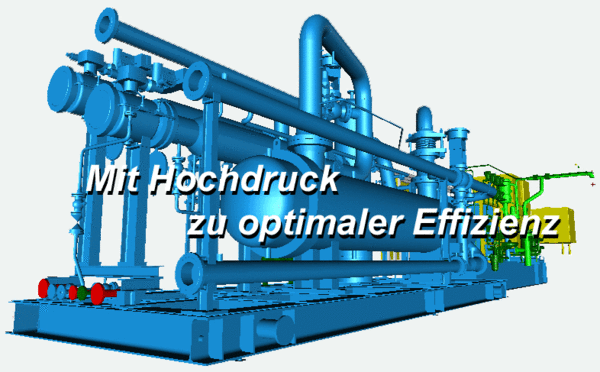
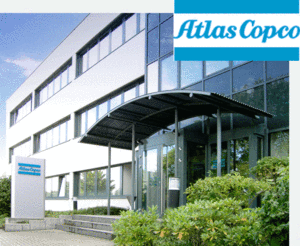
Atlas Copco Energas GmbH (ACE) is a world leader in generators, compressors and turbo expander technologies. The German office of the global company, based in Cologne, provides solutions which encompass standard and custom-produced air and gas compressors, as well as turbo expanders, whose unique energy recovery capabilities provide significant cost benefits by tapping resources ranging from solar collectors and natural gas pressure let down, to waste heat from various manufacturing processes. Always on the lookout for innovative technology and new ideas, while nurturing close, collaborative client relationships, ACE is constantly striving to further increase productivity.
ACE operates in a market space where individual client requirements demand custom solutions. The daily work of its ca. 400 staff members tends to focus on single part production or small job lots. It is very unusual for ACE to produce more than 40 identical installations; often, it’s significantly less. As a result, each project places sophisticated demands on design and production engineers, even if a number of standard components, such as couplings, coolers, containers, mounting bases etc., are sourced from external suppliers. In addition to the design tasks, communication with customers and partners is absolutely crucial to each project.
Computer Aided Design – Modern Processes, Longstanding Tradition, and Remarkable Efficiency
As well as focusing intensely on the quality of its product portfolio, ACE continuously strives to optimise its design, development and production processes. Even in the early dawn of CAD systems, ACE recognised the benefits to be reaped from computer aided design. The company first decided to introduce the MEDUSA MCAD system nearly twenty years ago, and thus became one of the pioneers of this exciting new technology.
What started in May 1986 with two seats of the basic 2D module, augmented by Parametrics and the Bacis programming language, has now developed into a full-fledged, comprehensive solution, equal to the company’s diverse remit. ACE’s highly skilled design engineers currently run around 50 basic seats of MEDUSA under Windows. These are supplemented by a series of high productivity MEDUSA modules, whose numbers varies with their degree of use.
Parametrics (17 licenses) ACE uses this powerful design automation module for producing 2D and 3D parametric designs. It automatically calculates and takes into account the geometric (tangential, angular, symmetric, collinear etc.) relationships between elements, allowing users to quickly and easily create parts families, simulate 2D movements, or validate design integrity. Engineers can control parametric 2D or 3D designs interactively, or use the Bacis1 and Bacis2 programming tools to automate the process.
MEDUSA 3D (9 licenses) This sheet-based 3D modelling approach allows designers without any 3D expertise to use MEDUSA’s 2D tools to generate even complex 3D models. An integrated viewer lets users interact with near life-like models by zooming, spinning and panning.
MPDS (4 licenses) ACE uses this comprehensive solution for all of its complex factory layout and plant design tasks, to include the design and management of equipment, piping, and steel construction. Engineers can zoom, pan and interact with the 3D installation from any perspective in colour-coded views. MPDS combines the speed and precision of interactive 3D computer aided design with the information management capabilities of relational database technology.
P&ID (5 licenses) This module allows designers to produce intelligent, multi-sheet Process and Instrumentation Diagrams and corresponding reports for the entire project.
MEDEA (6 licenses) ACE’s electrical engineers use MEDUSA’s sophisticated Electrical Design Application to create circuit diagrams, terminal strip diagrams, cable and wiring plans, schematic designs, etc. Circuit diagrams form the basis of the MEDEA concept; all other diagrams are updated accordingly.
Interfaces (IGES, DWG/DXF, VRML, ISOGEN) and HPGL plotter driver
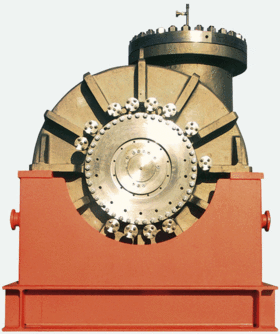
Naturally, time stands still for no engineer. Business environments are characterised by constant and often fundamental change – not only in technology – now more so than ever. Like any global company, Atlas Copco Energas GmbH has had to adapt and change its business processes and communication strategy to deal with the pressures presented by globalisation and distributed working. Typical of a company whose structures have developed over decades, ACE’s IT landscape is made up of a multitude of systems. The company’s main drive is to use those tools that are most productive and effective for the task at hand – as long as they fit into the existing IT landscape – rather than deploy a single-vendor solution.
In 2001, ACE decided to exploit the benefits of interactive 3D modelling by deploying PTC®’s Pro/ENGINEER® software. Not that this move heralded the end of MEDUSA at the company: MEDUSA and Pro/ENGINEER, far from being seen as competitive systems, work hand in glove in a strategy which looks to exploit the diverse strengths of each system in order to find the most efficient and cost effective route to achieving the desired result. MEDUSA’s excellent interoperability with Pro/E, coupled with its powerful design automation capabilities and its “by engineers for engineers” approach to product design, have held it in good stead.
Heinz Büchen, CAD Systems Manager at Atlas Copco Energas GmbH, explains: „Naturally we do from time to time review the deployment of MEDUSA. But we have continually reached the same conclusion. MEDUSA distinguishes itself through its sophisticated design automation capabilities, its surpassing stability, and its flexibility.“
Internal and External Flexibility
Flexibility in all arenas of IT deployment is becoming more and more essential. Because of its open and flexible nature, MEDUSA can be implemented as part of a heterogeneous systems landscape, and customised to meet diverse design challenges.
– Communication: Design data passes between groups of stakeholders, so communication is key. ACE’s engineers regularly forward design details to other departments as part of the internal product lifecycle process. They also need to exchange data with clients, subsidiaries, partners and suppliers throughout the world. The many interfaces available with MEDUSA (including IGES, DXF/DWG, and Pro/E), as well as the system’s highly customisable nature, make it ideal for today’s global and distributed development, production and delivery environment.
– Systems Integration: Using MEDUSA’s own Bacis programming language, or programming interfaces such as C, Java or FORTRAN, allows designers to optimise the system’s menu structures and integrate other company-specific applications. MEDUSA is ideal for creating and integrating client-specific customisations, and this was one of its main selling points when ACE first decided to deploy the solution. ACE has always been keen to get the most out of MEDUSA’s powerful tools, achieving an enviable degree of process automation, which has been perfected over time.
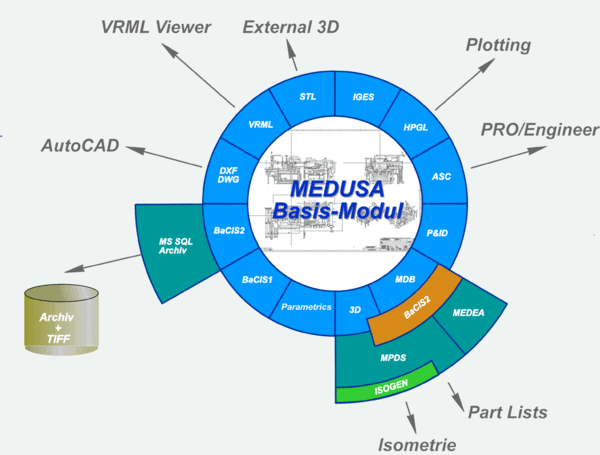
– Process Automation: ACE’s impressive process automation has been achieved by combining MEDUSA’s Parametrics module with the Bacis1 programming language. Nowadays, engineers simply enter installation or design parameters, which are processed by custom Bacis programs, reducing the design times for generating complex drawings from what was formerly several days to – in many cases – less than one hour. According to Heinz Büchen, CAD Systems Manager at Atlas Copco Energas GmbH, this affords MEDUSA a unique position, which tends to nip any discussions about alternative CAD solutions in the bud. „The exceptional degree of productivity we have been able to achieve with MEDUSA lends us a truly competitive edge. We are obviously always on the lookout for ways to improve, but in the field of design automation, MEDUSA is simply outstanding.“
ACE’s realistic approach stops short of demanding 100% design automation. It is necessarily the case that certain design details require manual intervention, or that automating some complex technical processes would require an incredibly large programming effort in order to achieve further automation. Custom design automation programs require, by their very nature, a significant amount of programming effort up front. They do, however, quickly recoup the outlay, by offering huge time and cost savings, as well as immense quality gains.
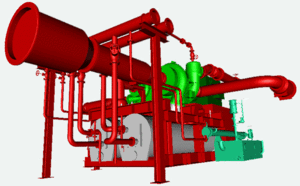
– 3D Modelling: ACE’s automation capabilities are not limited to 2D drawings, but extend well into the realm of 3D model creation with MEDUSA. One of the main benefits of the unique sheet-based modelling approach is its simplicity: it allows non 3D experts to quickly create even complex 3D models based on existing 2D data. MEDUSA uses “link lines” to assign depth to 2D geometry, and allows single geometries to be combined using Boolean operations. The process, conceived to augment powerful drafting functionality, rather than compete with pure 3D systems, clearly shows that MEDUSA, especially in combination with the Factory Layout and Plant Design System MPDS, is much more than a simple drafting solution.
– Legacy Data: Companies like ACE, which have accumulated many decades’ worth of design data, must ensure that this valuable intellectual, creative and business capital remains an active part of their future business, rather than sinking into oblivion in old filing cabinets and archives. Atlas Copco Energas GmbH holds approximately 300,000 designs in paper format or on microfiche. A large proportion of this data has recently been scanned and entered into the well-known ERP system SAP®. MEDUSA can reuse this raster data; engineers can combine it with new vector-based geometry in order to modify existing parts, or use it as the basis for new designs.
The Right Partner: Key to Success
We all know that in the end, however, it is people who make the difference in an organisation; and had it not been for the right CAD partner, engineers at Atlas Copco Energas GmbH might never have developed their exceptional product loyalty. ACE is far from the only major industrial player that holds the established systems vendor CAD Schroer GmbH (CSG), which took over the whole MEDUSA product line from PTC in 2001, in high esteem. CSG is renowned for its commitment to strong and lasting customer relationships, as well as to technically competent, practical advice and consultancy, firmly based on its own strong grounding in the engineering world.
According to Heinz Büchen, the successful integration of CAD solutions at Atlas Copco Energas GmbH is, for the most part, directly attributable to CAD Schroer and its dedicated staff members. He notes that since CSG’s takeover of MEDUSA, customers have seen an invigorating thrust of energy and innovation, made possible only by the unreserved commitment and dedication the company has shown towards the product and its customer base.

